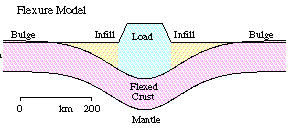Prof. Anthony B. Watts
Professor of Marine Geology and Geophysics
Lithospheric flexure
Plate tectonics is based on the assumption that the Earth's outermost layer, or lithosphere, behaves rigidly on long (i.e. > 106 a) geological time-scales. The main evidence for its rigidity has come from studies of the way that it responds to surface loads such as ice-sheets, sediments, and volcanoes. In most cases, the response takes the form of a simple bending, or flexure, of the crust. By comparing observations of flexure to calculations based on simple elastic and viscoelastic plate models it is possible to constrain the long-term strength of the lithosphere.

The elastic thickness of the oceanic lithosphere

The long-term strength of extended continental lithosphere
One of the more controversial topics in flexure studies is the question of the long-term strength of extended continental lithosphere. Some workers have proposed (based on gravity modelling studies) that extended continental crust is weak during rifting and has remained so since then. Why extended continental lithosphere is weak is difficult to explain because oceanic lithosphere would in all likelihood increase its strength following a heating event. Some workers have suggested that rifting results in a catastrophic reduction in the strength of the mantle while others have speculated that the mantle recovers its strength but, is somehow de-coupled from the strong uppermost crust. We have been carrying studies to determine the elastic thickness at rift-type basins that takes into account the possibility of strength during rifting. Preliminary results at the Gabon margin, offshore West Africa show it to be highly segmented as regards its long-term strength with strong zones that abut weak ones. Nevertheless, there is evidence at the Amazon margin that the elastic thickness increases with age since the initiation of rifting
The elastic thickness of continental lithosphere
Although it has been suggested that the elastic thickness of continental lithosphere shows a similar dependence with age, as does the oceanic lithosphere, it is difficult to explain continental elastic thickness estimates by a single set of thermal parameters. A majority of continental elastic thickness estimates, especially those from extended regions, are relatively low and in the range of 0-20 km. Only in the cool cratonic interiors does the continental lithosphere appear capable of showing any degree of long-term strength. We have been using high-resolution gravity anomaly and topography data sets and forward and "inverse" modelling techniques to estimate the elastic thickness of the continental lithosphere. Results in South America (summarised in the figure below) show that the elastic thickness varies spatially from high values over Brazilian and Guyana shields to low values over the sub-Andean basins. We have speculated that the low values correspond to regions that had been rifted during a previous extensional event.
Collaborators: Shijie Zhong (Boulder, CO), Marta Perez-Gussinye (University of Bremen) and the late Evgenii Burov (UPMC, Paris)
Return to Tony Watts home page

